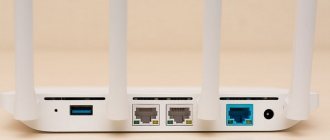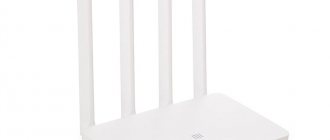TOP 7 best Xiaomi Wi-Fi routers
We are not sure that there is any point in talking at length about the criteria for selecting routers for rating. Most users are very familiar with Xiaomi's corporate style, so it will be difficult to surprise anyone either in terms of design or in terms of price-quality ratio. And, of course, not because they are bad, but because of their consistently high level. True, in terms of diversity, the manufacturer is, to put it mildly, not impressive. Sometimes you have to look for differences between models with a magnifying glass. However, we managed to find seven quite diverse devices, each of which deserved its own place in the ranking.
Xiaomi Mi Wi-Fi Router 4C
Xiaomi has many budget routers available in its product range. One of the best in this class is the Router 4C model, which can be found in Russia for a modest 1100-1500 rubles. The device is made in the manufacturer’s corporate white color and has 4 antennas, which is unusual for such affordable solutions.
But if you want to buy a router from Xiaomi for dual-band operation or high speed, then take a closer look at another model. This router only supports 2.4 GHz and only within the 802.11n standard. The maximum connection speed “over the air” here is only 300 Mbit/s. But it is stable and does not cut.
Advantages:
- attractive price;
- stable signal;
- range;
- official application;
- Beautiful design.
Flaws:
- cannot be mounted on the wall;
- non-standard plug.
Xiaomi Mi Wi-Fi Router 3A
If the capabilities of the 4C model are not enough for you, then you can choose a router from Xiaomi called Mi Wi-Fi Router 3A. It costs quite a bit more, but it has significantly more capabilities. There are 4 external antennas installed here with a gain of 6 dBi each. For a wired connection, the device has a pair of LAN ports (plus one WAN).
The maximum wireless connection speed in Router 3A is 300 Mbps for 2.4 GHz and 867 Mbps for 5 GHz.
The speed of each port is 100 Mbps, which is still sufficient for most tariff plans offered by providers. The “internals” of the router are represented by a 2-core MT7628A processor, as well as 64 megabytes of RAM and 16 MB of internal memory, which is enough for fast and stable operation of the device.
Advantages:
- work in two ranges;
- fast and stable operation;
- phone control support;
- four powerful antennas;
- high throughput;
- reasonable cost.
Flaws:
- lack of Russian language support;
- there are no alternative firmwares.
Xiaomi Mi Wi-Fi Router 4
The rating of the best Wi-Fi routers from Xiaomi continues with the Router 4 model. Despite its name, it is functionally closer to 3A, not 4C. Visually, the routers differ, but not so much as to draw attention to this. The hardware platform in Router 4 has become better: a more powerful processor, more RAM (128 MB) and a larger flash drive (also 128 MB). The device supports all current wireless standards, including 802.11ac, and can operate in wireless mode at speeds of up to 1167 Mbps, of which 300 Mbps are at 2.4 GHz.
Reviews praise the router for its ability to work in two bands at once, a large range and no speed reduction. An important advantage of the “four”, for which it is worth paying more money, are gigabit ports. There are only two of them here. In addition to the LAN pair, there is a WAN port, a charging connector, a Reset button and antenna mounts on the back. On the front there is a single indicator that can be turned off.
Advantages:
- two Wi-Fi bands;
- gigabit ports;
- excellent hardware;
- powerful antennas;
- good combination of price and functionality;
- excellent range;
- signal stability.
Flaws:
- Chinese.
Xiaomi ZMI 4G
So we have come to the middle of the rating, where a model without the usual “Mi Wi-Fi” in the name is located. And all because ZMI 4G is radically different from its counterparts. It is mobile and can be used absolutely anywhere, not just at home near an outlet. As the name implies, this is a Xiaomi router with a SIM card. Thanks to this, the user can use the router with any cellular operator.
Externally, ZMI 4G is as similar as possible to the manufacturer’s modern power banks. And this is not in vain, because inside the device there is a 7800 mAh battery, which not only powers the router, but also allows you to recharge compatible devices via a USB port.
Using the router is as simple as possible. It has only one button, a couple of ports (USB and Micro-USB), as well as three indicators that indicate the network signal, Wi-Fi signal and the charge of the built-in battery. To install a SIM card, the user needs to remove the back cover, under which, in addition to the slot, there are detailed specifications (in Chinese), a reboot hole and six screws holding the case together.
Advantages:
- support for 3G and LTE networks;
- maximum mobility;
- there is a powerbank function;
- multifunctional software;
- ease of use.
Flaws:
- signal stability depends on the quality of the network;
- The software has not been translated into Russian.
Xiaomi Mi Wi-Fi Router 3G
The top three are opened by Router 3G. And there is hardly any point in describing it in detail, because we have before us an almost complete copy of the Router 4 model. It uses exactly the same MT7621A processor from MediaTek, operating at a frequency of 880 MHz, and also has 128 MB of flash storage installed. But the RAM is a little more – 256 MB. Both LAN ports available in Router 3G boast a throughput of 1 Gbps.
If we highlight the shortcomings of the router based on reviews, they all relate to the same Chinese language. In general, this applies to most Xiaomi products, since they are not officially shipped outside of China. However, the user can more or less understand the web interface using the translator built into the browser. But the application for smartphones will have to be studied using user manuals on the Internet.
Advantages:
- USB 3.0 port with modem support;
- can be used as a file server;
- high-quality assembly and minimalistic design;
- excellent combination of cost and capabilities;
- low average cost of 2600 rubles;
- ability to work with external 4G modems
- simultaneous operation in two ranges.
Flaws:
- proprietary firmware, which is difficult to replace with another.
Xiaomi Mi Wi-Fi Router Pro
Compared to the inexpensive Xiaomi Wi-Fi routers discussed above, the Router Pro model can be called a fairly large device. Its depth is an impressive 146 mm, and its thickness is 66 mm, unusual for this class of device. The router is capable of operating simultaneously in two frequency bands (2.4 and 5 GHz), and its maximum speed for a wireless connection reaches 2533 Mbit/s.
Router Pro is equipped with all the necessary ports, including WAN, three LAN and USB. The Internet station is controlled through a proprietary application, available for both Android and iOS device owners. True, the language in it is exclusively Chinese.
One of the best Wi-Fi routers from Xiaomi offers users many useful features such as Firewall, media backup function, guest network, file, UPnP AV and FTP servers, as well as QoS and more. Like similar models from the manufacturer, the Router Pro model has the Xunlei download manager. This means that you can connect an external HDD to the router and configure it to download files.
Advantages:
- excellent build quality;
- highest range of action;
- premium appearance;
- ideal communication quality;
- high speed and stability via Wi-Fi;
- flexibility of customization.
Flaws:
- software is exclusively in Chinese;
- Custom firmware is not supported.
Xiaomi Mi Wi-Fi Router HD
The Router HD model took the lead in the review. And if you compare it with the previous one in the TOP, then the only thing that will visually indicate their difference is the color - here it is completely black. Otherwise, the routers are similar in terms of the set of ports, antennas and even dimensions. So why does the Router HD cost twice as much?
Firstly, this excellent Wi-Fi router from Xiaomi has more powerful hardware. ROM and RAM are no different here (256 and 512 MB, respectively), but the only USB port has improved, receiving version 3.0 instead of 2.0.
Secondly, there is built-in storage. The inscription 1 TB greets the user right on the box made of high-quality black cardboard and the device specifications. True, without knowing Chinese, you won’t find anything useful there. The hard drive, by the way, increased the weight of the Router HD by 65% compared to the Pro version.
Advantages:
- well-organized cooling;
- colorful design in all black color;
- HDD from Seagate with a rotation speed of 5900 rpm;
- a well-thought-out web interface (but, alas, only in Chinese);
- two fast processors guaranteeing fast operation;
- long-range and does not cut speed.
Flaws:
- no IPTV support;
- high (but justified) cost of about 13 thousand.
Everything for mobile users
The application is very convenient: when you first launch it, it automatically finds the network, prompts you to give the router a name, and enter a password to access the point and network. Just two screens - and you can use it.
Inside the application there is a full set of settings (unlike competitors who offer limited functionality to mobile users).
The first tab displays detailed statistics about the network, connected devices, and resource use. Here you can block or limit network access for connected gadgets.
The second tab contains a file manager for accessing USB-connected devices. You can use it like a regular mobile application; there are no restrictions on moving files.
The third tab provides access to the capabilities of the built-in clients for downloading http and .torrent links.
The last tab contains system settings, including the router operating schedule, scheduled reboots and firmware updates.
The application supports extensions. Among the most useful are Wi-Fi Optimization, built-in Task Manager and Manage Bandwidth. The Samba client is also included in the stock extensions.
The web interface (miwifi.com or 192.168.31.1) looks frankly pathetic compared to the well-thought-out application. Of course, the functionality is the same - but how can you compare cumbersome pages with convenient menus on a smartphone that allow you to control the device in two clicks?
However, only here you can debug VPN, DHCP, port-forwarding, operating modes (router, repeater, bridge).
Which Wi-Fi router from Xiaomi is better to buy?
As a result, we can say that the ideal choice for any task, with the exception, perhaps, of highly specialized professional needs, are the Router Pro and Router HD routers. As practice shows, the first one is usually more than enough for users, especially if they have an external HDD or do not need it at all. The ZMI 4G managed to significantly dilute the review of the best Wi-Fi routers from Xiaomi. And even if competitors offer worthy analogues, we were unable to immediately recall them. The remaining four are more or less similar to each other, but the more expensive the router, the more functions it offers, including speed, support for standards and bands, as well as installed hardware. Here you should make a choice based on your financial capabilities and needs for real work.
It seems Xiaomi stole Apple's designers
Previously, Xiaomi copied cheap Chinese crafts and produced either bricks or bars of soap.
But someone clearly helped them with the routers. Router 3 is a very stylish device. If it weren’t for the box with the Xiaomi logo, I would have thought about the Cupertino origin of the accessory. The designers weren't trying to design a starship, as happened with the latest Asus models.
A simple sloping panel, 4 antennas, a white body and ventilation holes at the bottom - nothing superfluous. It’s not a shame to put one in a prominent place - Xiaomi Router 3 can become an excellent element of any interior.
Moreover, it has a single two-color LED to display status. If it gets annoying, you can turn it off.
By the way, DamProdam.ru has an excellent selection of Xiaomi routers
The ports are hidden on the back panel (easy to hide), and additional information about the operation of the device can be obtained in the admin panel or through the application.
Other characteristics
In addition to the basic specifications, look at:
- The degree of network protection against hacking - WEP, WPA/WPA
- DLNA support for creating a local network between devices.
- Working in FTP server mode - files located on a storage device connected to the router will be available for playback on other devices.
- The number of antennas affects the signal distribution radius. Removable antennas can be replaced with more powerful ones.
- The amount of RAM - affects the speed of data processing.
- Maximum wireless connection speed.
- Number of LAN ports for connecting to PCs, laptops, consoles, MFPs, TV set-top boxes.
A special feature of Xiaomi routers is their division into Chinese and international versions. The latter is preferable due to the presence of the Russian language and European socket in the settings.











